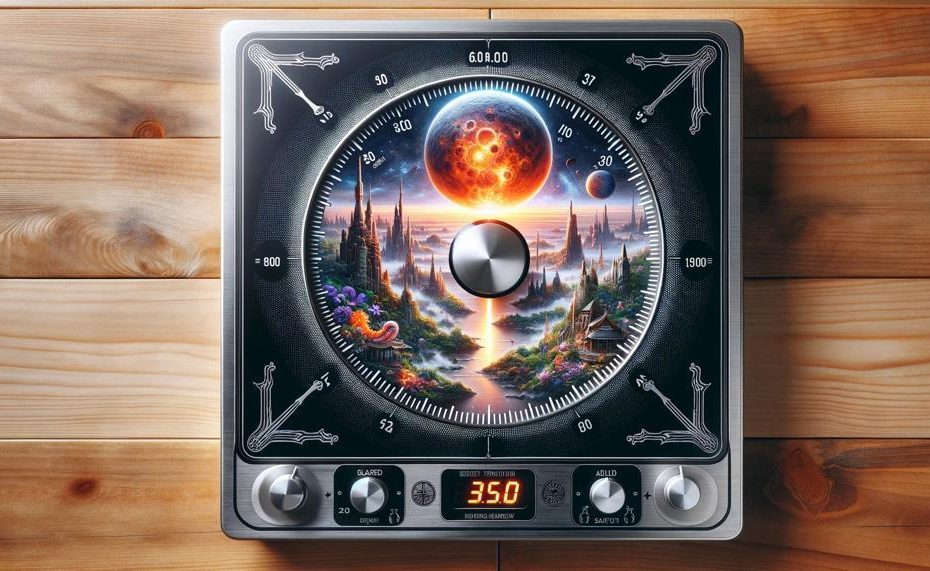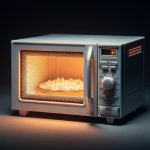Perhaps you’ve been eyeing the sleek and modern design of glass top stoves. But before making a purchase, it’s important to know how much weight these appliances can handle.
In this blog post, we’ll take a deep dive into the world of glass top stoves and explore their weight capacity.
So, how much weight can a glass top stove hold?
The typical weight restriction for a glass cooktop is fifty pounds, according to GE Appliances. This implies that you should never reach a high cabinet by standing on your cooktop, and that heavy canners may weigh more than a glass stovetop can support.
Let’s get started.
Contents
- 1 Do Glass Top Stoves Break Easily?
- 2 Can You Use Heavy Pots on Glass Top Stoves?
- 3 Is It Ok to Can on a Glass Top Stove?
- 4 What Can Damage a Glass Stove Top?
- 5 Glass top stove crack // what you MUST NOT do while using glass top stove hob or cooktop
- 6 Whirlpool Glass Top Stove Weight Limit
- 7 How Much Weight Can a Ceramic Cooktop Hold
- 8 How Much Weight Can Induction Cooktop Hold in Kg
- 9 How Much Weight Can Induction Stove Hold
- 10 Conclusion
Do Glass Top Stoves Break Easily?
To ensure the longevity of your glass top stove, it’s crucial to follow the recommended weight limit of 50 pounds. It’s best to keep the weight around 20-30 pounds, remove any unused items before adding more weight, and avoid combining high heat with excess weight. These simple handling tips can prevent any accidental damage to your stove.
In addition to following the weight limit, it’s important to handle the glass top stove with care. This includes being cautious and gentle when using and cleaning it, avoiding dropping heavy objects on the surface, and using cookware with smooth and even bottoms. Harsh cleaning products should also be avoided as they can cause damage to the glass surface.
Regularly inspecting the surface for scratches or cracks is also important in maintaining a glass top stove. Any signs of damage should be addressed immediately to prevent further harm. With proper care and maintenance, a glass top stove can be a beautiful and functional addition to any kitchen.
Can You Use Heavy Pots on Glass Top Stoves?
Using heavy pots on a glass top stove can pose several risks, such as damaging the stove and creating a safety hazard.
To guarantee the safety of both your stove and cooking experience, it is crucial to follow the weight limit recommended by the manufacturer, use suitable cookware, and handle it with caution.
Is It Ok to Can on a Glass Top Stove?
Yes, it is indeed possible to can on a glass top stove, but there are important precautions and risks to keep in mind. Glass top stoves are not designed to handle heavy loads or prolonged high heat, so it is crucial to adhere to the manufacturer’s guidelines and recommendations for safe usage.
Risks:
- Weight load limit: Glass top stoves have specific weight load limits that must be adhered to in order to avoid damage. The weight of a full canner can exceed this limit, so it is essential to consult the stove manufacturer for their specific limits.
- Heat distribution: Proper heat distribution is key for safe and efficient canning. Glass top stoves may not distribute heat evenly, leading to hot spots and potentially burning the food. It is important to use a canner with a flat bottom and smaller diameter than the burner.
- Automatic shut-off: Some glass top stoves have a safety feature that automatically shuts off if the heat becomes excessive. This could be problematic during prolonged high heat canning processes.
- Cookware compatibility: Induction glass top stoves require specific cookware with magnetic properties in order to function effectively. Regular glass tops do not have this requirement, but it is still important to choose appropriate cookware that will distribute heat evenly and not cause scratches or damage to the stove top.
Precautions:
- Check weight load limit: As mentioned before, it is crucial to consult the stove manufacturer for their specific weight load limit and follow their recommendations for safe usage.
- Use appropriate cookware: Canners with flat bottoms and smaller diameters than the burner are recommended for even heat distribution. Some newer pressure canners have special bottoms designed specifically for use on glass top stoves.
- Handle with care: Glass top stoves are more delicate than other types of stoves, so it is important to handle them with care when placing heavy canners on top. Avoid dragging the canner across the stove top to prevent scratches or damage.
- Monitor heat distribution: It is important to constantly monitor the heat distribution during the canning process to prevent hot spots and burning of the food. Adjust the temperature as needed and be mindful of the automatic shut-off feature if applicable.
What Can Damage a Glass Stove Top?
Glass stove tops are a popular choice for modern kitchens due to their sleek and smooth appearance. However, they can be easily damaged if not treated with care. The most common causes of damage to glass stove tops are heat, weight, and rough handling.
Excessive heat is the primary culprit for damaging glass stove tops. The glass can crack or even shatter when exposed to sudden changes in temperature or prolonged high heat. This can occur when using high heat settings for extended periods of time or placing hot cookware directly on the surface without a protective layer. To prevent heat damage, it is crucial to use cookware with flat bottoms and avoid using high heat settings for too long.
Weight is another factor that can cause damage to glass stove tops. These surfaces have specific weight limits that should not be exceeded. It is essential to avoid placing heavy objects, such as canning jars or cast iron pans, on the surface as this can lead to cracks or breaks. To prevent weight-related damage, always check the manufacturer’s guidelines for weight limits and avoid exceeding them.
Rough handling is also a major contributor to damaging glass stove tops. Dragging pots and pans across the surface or dropping heavy objects can create micro-scratches that weaken the glass over time, resulting in cracks or breaks. To prevent this type of damage, it is important to handle cookware with care and use gentle cleaning methods.
Apart from these common causes, using the wrong type of cleaner can also damage a glass stove top. Harsh chemicals or abrasive cleaners can scratch or etch the surface, making it more susceptible to cracking or breaking. It is crucial to use a cleaner specifically designed for glass stove tops and avoid applying too much force when scrubbing.
Glass top stove crack // what you MUST NOT do while using glass top stove hob or cooktop
There are various mistakes that are commonly made while using a glass top stove that can lead to cracks or damage. It is crucial to be aware of these mistakes and avoid them in order to keep your stove in good condition. Here are some important things to remember:
- Do not store heavy objects above your stove, such as glass containers or ceramic dishes that may accidentally fall onto the glass surface.
- When placing pots and pans on the stove, lift them instead of sliding them. Sliding heavy cookware can cause scratches or cracks on the delicate glass surface.
- Make sure to keep the bottom of your cookware clean. Any dirt, debris, or residue on the bottom can scratch the glass surface when placed on the stove.
- Always clean up spills or food remnants from the glass top after cooking. If left unattended, they can become burnt and difficult to clean, potentially causing damage.
- Avoid dragging cookware across the stove top. This can cause scratches and damage to the delicate surface of the glass.
- When placing cookware on the stove, always lift it and place it down gently. Dropping or slamming cookware onto the surface can result in cracks or shattering.
- Be gentle with your glass top stove. Avoid hitting it with heavy or sharp objects, and do not use abrasive cleaning tools.
- Refer to your manufacturer’s instructions for proper maintenance in order to maximize the life span of your stove. Each brand may have specific guidelines for cleaning and maintenance that should be followed.
- Taking care of your glass top stove and handling it with caution is crucial in preventing any potential cracks or damage. By following these tips and being mindful of how you use your stove, you can ensure that it stays in good condition for many years to come.
Whirlpool Glass Top Stove Weight Limit
The weight limit for the Whirlpool glass top stove is not an exact number and varies depending on the model. However, the maximum weight limit for the glass cooking surfaces (radiant, induction, gas-on-glass) of Whirlpool range and cooktops is 0lbs.
This is comparable to other leading brands like GE and Frigidaire, who also have weight limits ranging from 0-50lbs for their glass top stoves.
| Brand | Weight Limit for Glass Top Stove | Notes |
| Whirlpool | Up to 50lbs | The manufacturer does not specify a weight limit, but recommends staying under 50lbs for safety purposes. |
| GE | Up to 0lbs | The maximum weight limit for radiant glass cooktops according to the manufacturer. |
| Frigidaire | Up to 50lbs | The manufacturer does not specify a weight limit, but recommends staying under 50lbs for safety purposes. |
| Samsung | Up to 50lbs | The manufacturer does not specify a weight limit, but recommends staying under 50lbs for safety purposes. |
| LG | Up to 0lbs | The maximum weight limit for induction glass cooktops according to the manufacturer. |
It is important to keep in mind that these weight limits only apply to the glass cooking surface and do not take into account the weight of cookware or food being used. To ensure safety and prevent damage to your stove, it is crucial to consult the manufacturer’s instructions and recommendations for your specific model.
Furthermore, proper maintenance and handling of your glass top stove is essential in preventing cracks or damage. It is best to avoid placing heavy objects on the surface, sliding cookware, and using dirty or damaged pots and pans. Treat the glass delicately and clean up spills promptly to avoid any potential harm.
How Much Weight Can a Ceramic Cooktop Hold
The weight limit of a standard ceramic cooktop is typically around 50 pounds, which is similar to that of a glass top stove. However, this limit can vary depending on the brand and model of the cooktop.
There are several factors that can affect the weight capacity of a ceramic cooktop, including the following:
- Material and Quality: The type and quality of ceramic used for the cooktop can have an impact on its weight limit. Some materials may be more durable and able to withstand heavier weights than others.
- Design and Thickness: The design and thickness of the cooktop also play a role in its weight limit. A thicker and sturdier cooktop may be able to hold more weight compared to a thinner one.
- Manufacturer Recommendations: It is crucial to follow the recommended weight limit from the manufacturer as they have conducted stress tests to determine the safe weight capacity for their specific product.
- Proper Maintenance: Regular maintenance and care of the cooktop can also affect its weight limit. A well-maintained cooktop is less likely to develop cracks or structural damage that can compromise its weight capacity.
How Much Weight Can Induction Cooktop Hold in Kg

The maximum weight an induction cooktop can hold is approximately 20 kilograms (44 pounds). However, this capacity differs depending on the brand and model. It is crucial to not surpass this limit to prevent any potential harm or mishaps.
In the world of cooking, appliances come in all shapes and sizes, each with their own unique features. Induction cooktops have become a popular choice for their sleek design and efficient cooking capabilities. However, with great power comes great responsibility, and it is essential to understand the limitations of these appliances.
When considering the weight capacity of an induction cooktop, it is important to keep in mind that it is not just about the physical weight being placed on the surface. Factors such as heat distribution and stability also play a significant role. Exceeding the recommended weight limit can cause uneven heat distribution, leading to undercooked or burnt food, and may even damage the cooktop itself.
It is crucial to follow the manufacturer’s guidelines and not push the boundaries when it comes to weight capacity. This ensures not only the longevity of your appliance but also the safety of those using it. As tempting as it may be to stack heavy pots and pans on your induction cooktop, it is always better to be safe than sorry.
How Much Weight Can Induction Stove Hold
When it comes to induction stoves, the weight limit is usually capped at 50-60 pounds, whereas traditional gas or electric stoves can handle up to 200-300 pounds.
While traditional stoves may boast a higher weight limit, advancements in technology have enabled induction stoves to become more resilient and dependable.
Conclusion
In conclusion, when considering a glass top stove for your kitchen, it is essential to take into account its weight capacity. These appliances typically have a recommended weight limit of 50 pounds, and it is crucial to handle them with care and avoid surpassing this limit.
Along with physical weight, factors such as heat distribution, cookware compatibility, and proper maintenance also play a significant role in preserving the integrity of your glass top stove.
However, it’s worth noting that the weight capacity may vary depending on the brand and model. For instance, Whirlpool glass top stoves can hold up to 50 pounds, while ceramic cooktops have a similar weight limit. Induction cooktops, on the other hand, have a slightly lower weight limit of approximately 20 kilograms (44 pounds), but still offer efficient cooking capabilities.
It’s important to keep in mind that weight capacity is not solely about physical mass but also takes into consideration factors such as heat distribution and stability. Exceeding the recommended weight limit can result in uneven heat distribution and potential damage to your appliance.
To sum up, understanding the weight capacity of your stove is vital for both its functionality and safety. By adhering to manufacturer guidelines and handling your glass top stove with care, you can ensure its longevity and enjoy all the benefits of having a sleek and modern appliance in your kitchen.





